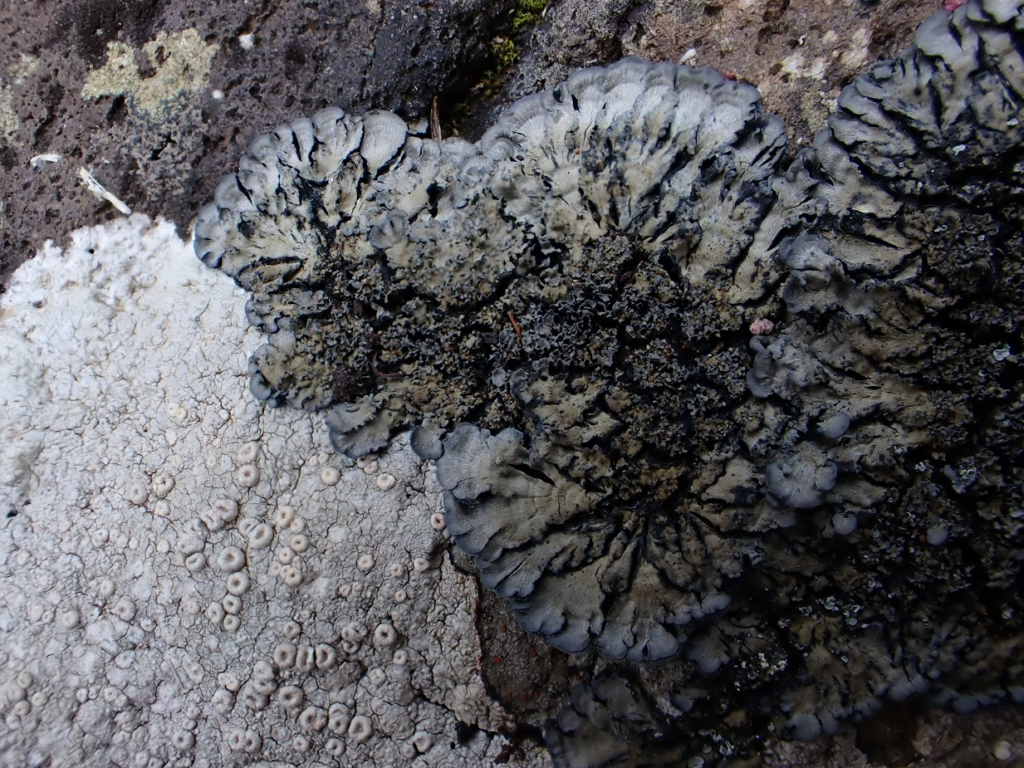Since I started ‘doing lichens’ in 2020, the potential for combining lichenology and climbing has been at the front of my mind. The places that ropes let you access are seldom visited by lichenologists and I’ve always speculated that hidden gems might be revealed by a more ‘adventurous’ approach to lichen hunting. Earlier this summer, I was able to realise this potential on the basalt cliffs of Pentire Point.
Pentire is a cliff that’s on the radar of a lot of climbers in the South West and further afield, mainly due to the appeal of the Great Wall and its most famous routes: ‘Eroica’, ‘Black Magic’, and ‘Darkinbad the Brightdayler’. Andy Moles wrote about Darkinbad on UKC and as folks familiar with the work of James Joyce will know, anything that invokes Ulysses (or worse still Finnegan’s Wake) should be approached with considerable caution.

My aspirations for the day were a bit more modest and I suggested to my pal Dexter that we climb a VS called ‘Our Stars, Our Sky’, a wandering a traverse above the sea. It was scorching hot and the north-facing sea level crags of Pentire offered a welcome escape from the sun. Dex led the zig-zagging first pitch which was covered in a slick of the ‘tar lichen’ Hydropunctaria maura (more on this in another blog) while I took the second, a fun traverse back above the rocks below.


As we reached the top and scrambled back to our bags something caught my eye on a shady outcrop. I like to think I’m developing a pretty good eye for lichens and they tend to jump out at me from the background, especially if they’re something unusual. The form of this particular lichen was familiar but it seemed out of place. I was sure I was looking at Pectenia atlantica, a species I know pretty well from oceanic woodland in the northwest of Scotland.

I knew that this species could be found in the South West and I wrote off its rocky habit here as an interesting anomaly. Basalt’s an interesting rock – not as acidic as the granite that makes up so much of the climbable terrain in Cornwall – and where it’s found it often hosts unusual lichens, so seeing P. atlantica here wasn’t a completely ridiculous proposition. Something did feel different about this specimen but I couldn’t put a finger on it, again attributing its not-quite-right appearance to its growth on a not-quite-right substrate. I was pleased to go home with what was an unusual, if not groundbreaking, record.

Later that evening, I was reading through the Pannariaceae chapter of the Lichens of Great Britain and Ireland (a lichenologist’s bedtime reading is edgy stuff) and something jumped out at me: the description for Pectenia ligulata. Superficially similar to P. atlantica, P. ligulata is often found on coastal rocks, just like those that I’d found my specimen on. The main difference between the two is in some special structures that some lichens have; whereas P. atlantica has dense isidia, P. ligulata has spoon-shaped schizidia (sorry for the technical terms – lichenology has a lot of them and I’ll do some explainers in future blogs). I looked back at some photographs I’d taken, and my specimen did indeed appear to have spoon-shaped structures. Nice.

However, before I settled on my new identification I had another problem to resolve; whereas there were several records for P. atlantica in the region, there were none for P. ligulata. In fact, the only record for the species in all of England was made nearly 25 years previously by Peter James on the Isles of Scilly.

Faced with the prospect of such a rarity, I reached out to fellow lichenologists who might be familiar with the species. The agreement was unanimous – I did indeed have P. ligulata and its first record for mainland England. What a find! If there ever was justification for combining climbing and lichens this was it. I can’t wait to get out and explore more cliffs with a lichenologist’s eye; who knows what else might be out there.
Many thanks to Maxine Putnam, Heather Paul and Brian Coppins for their help with identifying the lichen, and to Dexter for continuing to climb with me despite my inclination to stare at rocks when I could be climbing.
A version of this post was published in the Winter 2023 edition of the British Lichen Society Bulletin

